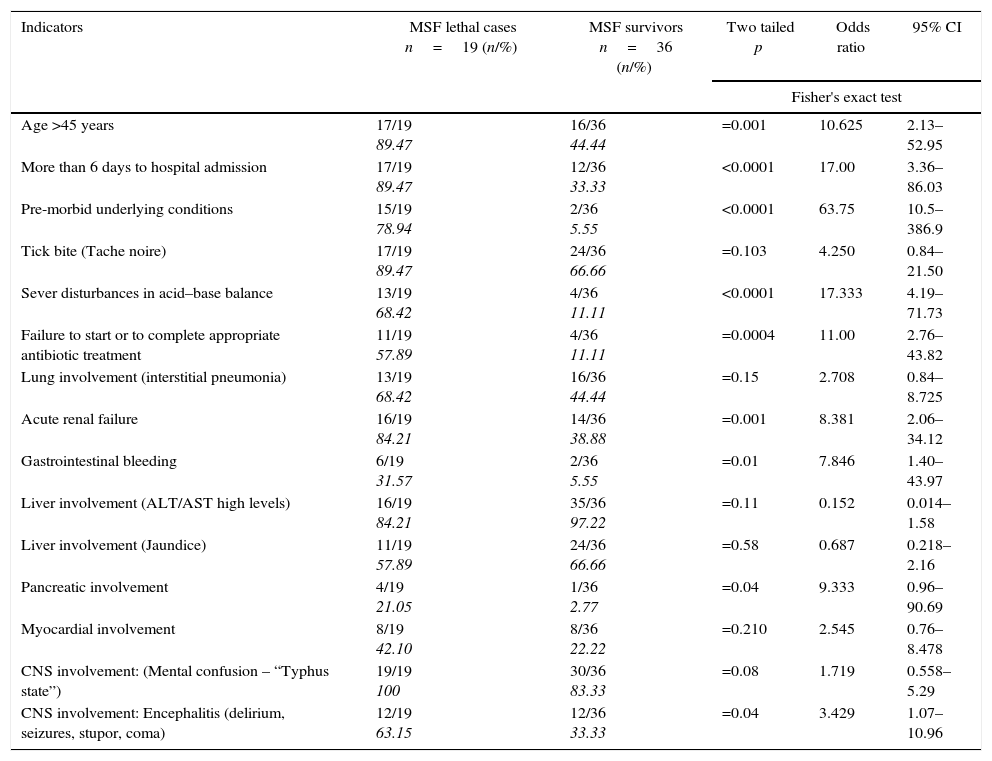As a result of globalization and growing tourism, imported cases of Mediterranean spotted fever (MSF) were reported in many non-endemic countries and regions.1 Molecular instruments such as PCR and sequencing have identified the etiologic agent – Rickettsia conorii subsp. conorii, strain Malish Seven.2 Rickettsiae are transmitted to humans by the bite of the dog tick Rhipicephalus sanguineus, and human contact with the tick intermediate hosts – domestic and stray dogs, is an important epidemiological determinant. The main clinical signs and symptoms of MSF are: a skin eschar (tache noire) at the site of tick bite, fever and flu-like manifestations such as headache, adynamia, anorexia, myalgia, etc., emerging 3–5 days before the onset of papular or maculopapular rash over the trunk and extremities, involving the hands and feet. In the past overlooked as a serious disease, at present it is known that MSF was wrongly considered a benign condition. In the early 1980s, D. Raoult reported a patient with a fatal outcome due to MSF and used the term “malignant” for the most severe forms of the disease.3 Since MSF has spread intensively in many European countries, a number of malignant, including fatal, cases have been described. The mortality rate reached 54.5% in hospitalized patients with neurological manifestations and multiorgan involvement.4,5
The purpose of this study was to outline the risk factors contributing to the fatal outcome in patients with malignant MSF. Fifty-five patients (30 men and 25 women) with malignant forms of MSF were included in the study. They were divided in two groups: Group I comprised 19 fatalities (34.54%) with mean age of 59.55±4.09 years; Group II comprised 36 survivors (65.45%) with mean age of 47.22±5.81 years. MSF was confirmed by the indirect immunofluorescent assay (IFA), with at least a fourfold increase in the antibody titer to a specific R. conorii antigen (IFA test Rickettsia conori – Spot IF, BioMerieux, Marcy L’Etoile, France). IgG titers of ≥128 and/or IgM titers of >64 were considered indicative of acute infection. Based on our data, the risk factors for mortality in malignant MSF patients were: advanced age, delayed hospital admission, underlying chronic diseases, failure to start or to complete appropriate antibiotic treatment, and severe involvement of multiple organ systems, especially CNS (Table 1). Risk complications for death according to our data were: encephalitis with brain edema, acute respiratory distress syndrome and non-cardiogenic lung swelling, gastrointestinal bleeding, hemorrhagic-necrotizing pancreatitis, and acute renal failure. Laboratory factors associated with fatality were: leukocytosis with marked shift to the left; very high serum urea and creatinine levels; low levels of fibrinogen and prolongation of thrombin time; and serious acid–base balance disturbance.
Mediterranean spotted fever malignant forms: risk factors for fatal outcomes.
| Indicators | MSF lethal cases n=19 (n/%) | MSF survivors n=36 (n/%) | Two tailed p | Odds ratio | 95% CI |
|---|---|---|---|---|---|
| Fisher's exact test | |||||
| Age >45 years | 17/19 89.47 | 16/36 44.44 | =0.001 | 10.625 | 2.13–52.95 |
| More than 6 days to hospital admission | 17/19 89.47 | 12/36 33.33 | <0.0001 | 17.00 | 3.36–86.03 |
| Pre-morbid underlying conditions | 15/19 78.94 | 2/36 5.55 | <0.0001 | 63.75 | 10.5–386.9 |
| Tick bite (Tache noire) | 17/19 89.47 | 24/36 66.66 | =0.103 | 4.250 | 0.84–21.50 |
| Sever disturbances in acid–base balance | 13/19 68.42 | 4/36 11.11 | <0.0001 | 17.333 | 4.19–71.73 |
| Failure to start or to complete appropriate antibiotic treatment | 11/19 57.89 | 4/36 11.11 | =0.0004 | 11.00 | 2.76–43.82 |
| Lung involvement (interstitial pneumonia) | 13/19 68.42 | 16/36 44.44 | =0.15 | 2.708 | 0.84–8.725 |
| Acute renal failure | 16/19 84.21 | 14/36 38.88 | =0.001 | 8.381 | 2.06–34.12 |
| Gastrointestinal bleeding | 6/19 31.57 | 2/36 5.55 | =0.01 | 7.846 | 1.40–43.97 |
| Liver involvement (ALT/AST high levels) | 16/19 84.21 | 35/36 97.22 | =0.11 | 0.152 | 0.014–1.58 |
| Liver involvement (Jaundice) | 11/19 57.89 | 24/36 66.66 | =0.58 | 0.687 | 0.218–2.16 |
| Pancreatic involvement | 4/19 21.05 | 1/36 2.77 | =0.04 | 9.333 | 0.96–90.69 |
| Myocardial involvement | 8/19 42.10 | 8/36 22.22 | =0.210 | 2.545 | 0.76–8.478 |
| CNS involvement: (Mental confusion – “Typhus state”) | 19/19 100 | 30/36 83.33 | =0.08 | 1.719 | 0.558–5.29 |
| CNS involvement: Encephalitis (delirium, seizures, stupor, coma) | 12/19 63.15 | 12/36 33.33 | =0.04 | 3.429 | 1.07–10.96 |
CI, confidence interval; MSF, Mediterranean spotted fever.
Long time overlooked as a serious disease, at present, it is known that MSF is wrongly considered a benign condition. In this report we managed to identify risk factors associated with mortality in malignant forms of MSF. This approach is justified as the diagnosis in such cases is frequently a problem. We hope that our research would contribute to prompt diagnosis and prompt adequate treatment.
Conflicts of interestThe authors declare no conflicts of interest.





